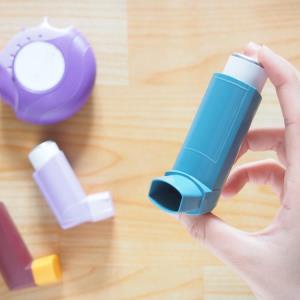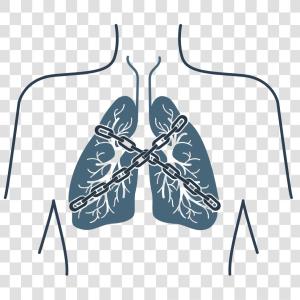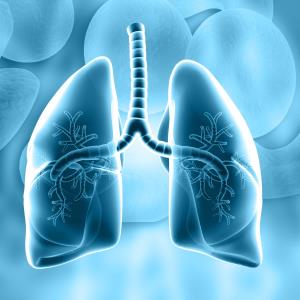Asthma Treatment
Principles of Therapy
Management Plans for Long-term Asthma Control
- Effective symptom control with minimal or no exacerbations
- Minimal or no daytime and nocturnal symptoms
- No limitations on activities, including exercise
- Minimal or no need for reliever treatment
- No emergency visits
- Normal or near normal pulmonary function
- Minimal adverse effects of medication
Therapeutic Strategies
- Depends on a control-based approach
- Treatment is continuously adjusted depending on patient’s response to therapy
- Involves a cycle of assessment, treatment and review of patient response
- Other strategies used include sputum-guided treatment and fractional concentration of exhaled nitric oxide
Managing Asthma Exacerbations
- Beginning therapy at home avoids delay in treatment along with giving the patient a sense of control over their asthma
- Degree of therapy administered at home will depend on the healthcare provider and the patient’s experience, availability of medicines and emergency care
- Home PEF measurements may be part of the home management strategy
- Degree of symptoms is generally a more sensitive predictor of early stages of asthma attack than PEF
- If patient’s asthma continues to deteriorate or suddenly worsens, consider transferring to an acute care facility
Initial Treatment of Asthma
- After diagnosis of asthma is made, it is recommended to start corticosteroid (inhaled, low dose) as soon as possible for better outcomes
- Depends on patient's presenting symptoms, risk factors, comorbidities and treatment preference
| Recommended Options for Initial Treatment | ||
| Presenting Symptoms | Children 6-11 years | Adults and Adolescents |
|
|
|
Preferred |
| Alternative |
||
|
|
|
Preferred |
| Alternative |
||
|
|
|
Preferred |
| Alternative |
||
|
|
|
Preferred |
| Alternative |
||
| Reference: Global Initiative for Asthma (GINA). Global strategy for asthma management and prevention: Updated 2023. 1As Anti-inflammatory reliever (AIR) 2As Maintenance and reliever therapy (MART) |
||
Management Plans for Long-Term Asthma
| Recommended Medications Based on Level of Control | ||
| Treatment Steps | Daily Controller Medications | |
| Children 6-11 years |
Adults and Adolescents ≥12 years | |
| Step 1 |
Preferred controller
Reliever
|
Controller
Preferred reliever
Alternative reliever
|
| Step 2 |
Preferred controller
|
Controller
Other controller options (any of the following):
Preferred and alternative reliever options same as Step 1 |
| Step 3 |
Preferred controller (any of the following):
|
Controller
Other controller options (any of the following):
Preferred and alternative reliever options same as Step 13 |
| Step 4 |
Preferred controller (any of the following):
Other controller options (any of the following):
|
Controller
Other controller options (any of the following):
Preferred and alternative reliever options same as Step 13 |
| Step 5 |
Preferred controller
Other controller option:
Preferred reliever options same as Step 1 |
Controller
Other controller options:
Preferred and alternative reliever options same as Step 13 |
| Reference: Global Initiative for Asthma (GINA). Global strategy for asthma management and prevention: Updated 2023. 1As anti-inflammatory reliever (AIR) 2Low-dose inhaled corticosteroids may be used separately or in combination with short-acting inhaled beta2-agonists. 3Budesonide/Formoterol or Beclometasone dipropionate/Formoterol combination may be given as maintenance and reliever therapy (MART). 4Should not take >12 doses (>8 doses for children) of Budesonide/Formoterol or >8 doses of Beclometasone dipropionate/Formoterol per day. 5May be considered in sensitized adult patients with allergic rhinitis and FEV1 >70% predicted. 6Expert referral is recommended for patients 6-11 years old with disease progression despite good adherence and correct technique. 7Tiotropium by mist inhaler is only to be given to patients ≥6 years of age with a history of exacerbations. 8Contraindicated in patients <6 years of age. 9Contraindicated in patients <18 years of age. 10Contraindicated in patients <12 years of age. 11Approved for patients ≥12 years of age. |
||
Stepwise Therapy Based on Control for Adults and Children ≥6 Years
For stepwise therapy of children ≤5 years, please see Asthma disease management chart in the latest edition of MIMS Pediatrics for further information
Step 1 - Use of as-needed controller
- Medications on an “as necessary” basis are given
- Reserved for patients with controlled asthma (<2x/month occurrence of symptoms, absent exacerbation risk factors)
- Use of as-needed low-dose inhaled corticosteroids plus Formoterol for symptom relief
- Patient adherence to medication should be considered when prescribing corticosteroids
- Should address risk factors for exacerbation and symptom control
Step 2 - Use of as-needed or daily controller
- For patients who require controller medications everyday in order to maintain control of their asthma
- May be used as initial therapy for treatment-naive patients with persistent symptoms
- Use of as-needed low-dose inhaled corticosteroids plus Formoterol for symptom relief
- Use of daily low-dose inhaled corticosteroid with long-acting beta2-agonist as initial maintenance controller treatment is an option for patients ≥12 years given controller medications for the first time
- Daily inhaled corticosteroids or as-needed inhaled corticosteroids plus Formoterol is a treatment option for patients with purely seasonal allergic asthma
Step 3 - Use of daily controller and reliever, plus as-needed reliever
- For patients who require controller medications everyday in order to maintain control of their asthma
- For patients ≥12 years of age, low-dose inhaled corticosteroids with Formoterol may be used as both maintenance and reliever treatment
- Addition of oral leukotriene modifiers or Theophylline to low-dose corticosteroids may be considered
- For children, increasing the dose of the corticosteroid from low to medium is preferred than adding a long-acting beta2-agonist
- Addition of house dust mite SLIT may also be considered in patients ≥12 years of age sensitized to house dust mite with allergic rhinitis and FEV1 >70% predicted
Step 4 -Daily controller and reliever therapy, plus as-needed reliever treatment continued
- Therapy usually requires multiple daily controller medications
- Treatment choice will depend upon what was previously used in step 3
- Consider expert referral if increasing the dose of inhaled corticosteroids fails or if symptom control remains poor and/or flare-ups persist
- Addition of house dust mite SLIT may also be considered in patients ≥12 years of age sensitized to house dust mite with allergic rhinitis and FEV1 >70% predicted
- Addition of oral leukotriene modifiers or Tiotropium for patients ≥6 years old with history of exacerbations, or increasing the dose of inhaled corticosteroids given with long-acting inhaled beta2-agonist may be considered if symptoms are still not controlled in Step 3
- For patients being considered for high-dose inhaled corticosteroids, advise should be given about the increased risk for side effects
- Tiotropium via mist inhaler may be considered for patients with history of exacerbations despite combination therapy in Step 3
- Long-acting muscarinic antagonists may be considered as an add-on therapy for patients ≥6 years old or inpatients ≥18 years as a combination inhaler if asthma is persistently uncontrolled despite medium- or high-dose of inhaled corticosteroid with long-acting beta2-agonist
- If symptoms are not controlled by step 3 medications, patient may be referred to a specialist for further diagnostic evaluation
Step 5 - Add-on treatment and expert referral
- For patients with persistent symptoms or exacerbations despite optimization of existing therapy, correct inhaler technique and good compliance
- Oral low-dose corticosteroids may be added to other controller medications
- May be effective in reducing the symptoms especially in some adults with severe asthma
- Associated with severe side effects, hence, should only be given to patients with uncontrolled symptoms and/or frequent exacerbations despite step 4 medications
- Long-acting muscarinic antagonists may be considered as an add-on therapy for patients ≥6 years old or inpatients ≥18 years as a combination inhaler if asthma is persistently uncontrolled despite medium- or high-dose of inhaled corticosteroid with long-acting beta2-agonist
- Addition of Azithromycin may be considered if symptoms are still not controlled
- Add-on anti-IgE (Omalizumab) may be considered for asthma patients aged ≥6 years old with allergic component when control is not achieved despite combination of other controllers
- Add-on anti-IL5 (Mepolizumab, Reslizumab) and anti-IL5 receptor (Benralizumab) may be considered for patients with severe uncontrolled eosinophilic asthma despite adherence to step 4 regimen
- Add-on anti-IL4α receptor (Dupilumab) may be considered in patients aged ≥6 years old with severe eosinophilic or type 2 asthma or in patients aged ≥12 years old in need of oral corticosteroid maintenance therapy
- Add-on anti-thymic stromal lymphopoietin (anti-TSLP) (Tezepelumab) may be considered for patients aged ≥12 years old with severe asthma
- Add-on Azithromycin may be considered for eosinophilic and non-eosinophilic asthma patients with persistent symptomatic asthma despite reduction of exacerbations and improved quality of life with moderate- to high-dose inhaled corticosteroid-long-acting beta2-agonist combination therapy
- Add-on low-dose oral corticosteroids may only be used on patients with severe asthma if with poor symptom control and/or frequent exacerbations despite good inhaler technique and adherence to step 4 regimen, and after other contributory factors and add-on treatments have been excluded
- If symptoms are not controlled by step 4 medications, patient should be referred to a specialist for further diagnostic evaluation including assessment of phenotype and additional treatment
- Treatment may be reassessed based on the patient’s eosinophilia seen during sputum exam
- May be applied if with previous history of high-dose inhaled corticosteroid or inhaled corticosteroid with long-acting beta2-agonist therapy
Maintaining Control of Asthma
- Step-wise approach to therapy is the advancement to the next step of therapy if control is not reached or obtained with the current treatment
- Treatment should be individualized based on the availability of antiasthmatic medications, resources of healthcare system, individual patient circumstances and cost
Step Down
- Once control is achieved and maintained and has stable lung function for 2-3 months, gradual step-wise reduction in treatment may be attempted
- Not applicable for patients at risk of exacerbations or persistent airflow limitation
- Patients currently on Step 2:
- Inhaled low-dose corticosteroids may be reduced to once-daily dosing
- May switch to as-needed low-dose inhaled corticosteroid-Formoterol
- May switch to inhaled corticosteroids whenever short-acting beta2-agonist is taken
- Discontinuation of inhaled corticosteroid therapy is not advised
- Patients currently on Step 3:
- Shift to once-daily dosing of low-dose inhaled corticosteroid-long-acting beta2-agonist combination
- Shift to once-daily dosing of inhaled corticosteroid-Formoterol maintenance dose and continue as-needed low-dose inhaled corticosteroid-Formoterol reliever
- Reduce moderate-high dose inhaled corticosteroid dose by 50%
- Addition of leukotriene modifiers may be considered when stepping down inhaled corticosteroids dose
- Patients currently on Step 4:
- For patients on moderate-high dose inhaled corticosteroid-long-acting beta2-agonist combination maintenance regimen:
- May reduce dose of inhaled corticosteroids by 50%
- Switch to a lower maintenance dose inhaled corticosteroid-Formoterol as MART
- Reduce inhaled corticosteroid-Formoterol therapy from medium-dose to low-dose then continue as-needed low-dose corticosteroid-Formoterol reliever regimen
- Reduce high-dose inhaled corticosteroids by 50% and continue second controller
- For patients on moderate-high dose inhaled corticosteroid-long-acting beta2-agonist combination maintenance regimen:
- Patients currently on Step 5:
- Continue high-dose inhaled corticosteroid-long-acting beta2-agonist combination
- Reduce dose of oral corticosteroids
- May use sputum-guided approach
- May switch to alternate-day treatment or replace with inhaled forms
- Replace oral corticosteroids with high-dose inhaled corticosteroids
- Add biologic therapy if T2 high severe asthma
- Patients on high-dose inhaled corticosteroid-long-acting beta2-agonist combination with other add-on agents should be referred for expert advise
- Identify the patient's inflammatory type based on sputum eosinophil count or FeNO to assess eligibility to various add-on treatments
Step Up
- Consider step-up if control is not maintained (review patient medication techniques, compliance and non-pharmacological control)
- Sustained step-up of 2-3 months duration may be considered in patients who are not responding to initial treatment regimen despite good treatment adherence and removal of modifiable risk factors
- Short-term step up of 1-2 weeks involved increasing the dose of inhaled corticosteroid for 1-2 weeks for special situations such as in the presence of viral infections or seasonal allergens
- Day-to-day adjustment of as-needed inhaled corticosteroid-Formoterol doses based on symptoms should be considered in patients given Budesonide-Formoterol or Beclometasone-Formoterol combination as maintenance or reliever therapy
Exercise-Induced Bronchoconstriction
- Reliever medication should be given prior to exercise or to relieve post-exercise symptoms
- Treatment is reserved for patients with controlled asthma who develop exercise-induced symptoms or to those in whom exercise-induced bronchoconstriction is the only symptom
Controller Medications
Preferred Therapy
- Corticosteroids (Inhaled)
- These are the most effective anti-inflammatory medications used for asthma and are the preferred controller medications for patients with persistent asthma of all levels of severity
- Discontinuation is followed by deterioration of control within weeks to months in some patients
- To minimize side effects, the following can be done:
- Inhaler technique should be optimized to minimize systemic medication absorption
- The patient should rinse their mouth after use of inhaled corticosteroids or use a spacer to reduce topical adverse effects
- Upon achievement of control, corticosteroids should be titrated carefully to lowest effective dose to maintain control
- If need to increase dose, it is advisable to add another agent first (ie long-acting beta2-agonist or leukotriene receptor antagonist) rather than increasing the dose of inhaled corticosteroids
- Combination with Formoterol as initial treatment is preferred over daily inhaled corticosteroid monotherapy due to issues with treatment adherence
- In patients taking short-acting beta2-agonists, inhaled low-dose corticosteroid therapy may be given without Formoterol, taking into account patient's history of treatment adherence
- Addition of long-acting inhaled beta2-agonist is preferred when daily low-dose inhaled corticosteroid fails
- Improves lung function and symptoms, reduces exacerbations, decreases need of short-acting beta2-agonists, achieves faster clinical control of asthma, and may also be used to prevent exercise-induced asthma
Alternative or Add-On Therapy
- Anticholinergic (Inhaled)
- Eg Tiotropium bromide, Ipratropium bromide
- Considered alternative to short-acting inhaled beta2-agonists because they may have a slower onset of action and/or higher risk for side effects
- Have an additive effect when nebulized together with a short-acting beta2-agonists for exacerbations of asthma
- Considered in patients who experience adverse effects (eg tachycardia, arrhythmia, tremor) from short-acting beta2-agonists
- May help improve lung function and decrease interval to next asthma exacerbation
- Ipratropium bromide may only be considered for exacerbations and not for long term management of asthmatic children
- Azithromycin
- May be considered as an alternative add-on off-label therapy for uncontrolled or severe asthma
- Sputum exam for atypical mycobacteria should be conducted prior to therapy initiation
- Beta2-Agonists (Inhaled, Long-acting)
- Has no effect on airway inflammation, hence not used as a monotherapy
- Most efficacious when given together with inhaled corticosteroids
- Rapid clinical control of asthma is achieved than when inhaled glucocorticosteroids are given alone
- Studies have shown increased mortality risk when given alone; should not be used as a substitute for corticosteroids
- Causes improved symptom scores, decreased nocturnal asthma symptoms, improved lung function, decreased use of short-acting beta2-agonists, and reduced number of exacerbations
- Beta2-Agonist (Oral, Long-acting)
- May be considered as an alternative add-on therapy and should always be given with inhaled corticosteroids
- Only used on rare occasions when more bronchodilation is needed
- Less effective than inhaled beta2-agonists and poses increased risk of side effects
- Corticosteroids (Oral)
- Based on Global Initiative for Asthma (GINA) 2023, low-dose oral corticosteroids (≤7.5 mg/day Prednisone equivalent) may be considered as a last resort treatment for adults with severe asthma
- Should only be considered for adults with poor symptom control and/or frequent exacerbation despite good inhaler technique and adherence with Step 5 treatment and after exclusion of other contributory factors and availability of add-on treatments (eg anti-IgE, anti-IL5/IL5R, anti-IL4R, anti-TSLP)
- Long-term use (>2 weeks) may be required for severely uncontrolled asthma
- Based on Global Initiative for Asthma (GINA) 2023, low-dose oral corticosteroids (≤7.5 mg/day Prednisone equivalent) may be considered as a last resort treatment for adults with severe asthma
- Leukotriene Modifiers (Oral)
- May be used as an alternative for adult patients with mild persistent and Aspirin-sensitive asthma who are not able to tolerate inhaled corticosteroids or those who respond well to leukotriene modifiers
- When used as add-on therapy, may reduce the required dose of inhaled corticosteroid for patients with moderate to severe symptoms
- When used as monotherapy for control of asthma, leukotriene modifiers are less effective than low-dose inhaled corticosteroids
- Monoclonal Antibodies (Benralizumab, Dupilumab, Mepolizumab, Omalizumab, Reslizumab, Tezepelumab)
- Reduces exacerbations in patients with severe, uncontrolled asthma and improves lung function, asthma control and health-related quality of life
- Omalizumab is indicated for moderate to severe asthma with allergic component and allergic and nonallergic severe eosinophilic asthma not controlled by inhaled corticosteroids
- SC Mepolizumab, SC Dupilumab, SC Benralizumab, and IV Reslizumab may be considered for severe eosinophilic asthma not controlled by inhaled corticosteroids
- Dupilumab may also be considered in severe T2 asthma not controlled by medium- to high-dose inhaled corticosteroids plus ≥2 additional controller medications
- Use of Benralizumab and Dupilumab are contraindicated in patients <12 years of age; Mepolizumab in patients <6 years of age; Reslizumab in patients <18 years of age
- Tezepelumab is recently approved as an add-on maintenance treatment of severe asthma for patients ≥12 years of age
- Theophylline (Oral, Extended-release)
- Bronchodilator, which at low dose, has anti-inflammatory effects but with known adverse effects thus not recommended for routine use
- Monitoring of serum level is needed
- Bronchodilator, which at low dose, has anti-inflammatory effects but with known adverse effects thus not recommended for routine use
Reliever Medications
Preferred Therapy
- Corticosteroids (Inhaled) with Formoterol
- Combination of steroid with Formoterol is preferred for patients previously given Budesonide-Formoterol or Beclometasone-Formoterol maintenance and reliever therapy
- Reduces risk for severe exacerbation in adults and adolescents with mild asthma compared to short-acting beta2-agonist monotherapy
Alternative Therapy
- Beta2-agonists (Inhaled, Short-acting)
- Treatment option for relief of bronchoconstriction during acute episodes of asthma and are useful for pretreatment prior to exercise, to be used concomitantly with inhaled corticosteroids
- Reliever-only initial treatment ie as-needed short-acting inhaled beta2-agonist is no longer recommended due to accumulated reports of increased risk of exacerbations and lower lung function with short-acting inhaled beta2-agonist monotherapy
- Used only when necessary; increased use indicates that management should be re-assessed
- Concomitant use with corticosteroid is recommended with every intake of a short-acting inhaled beta2-agonist to prevent side effects of short-acting inhaled beta2-agonist monotherapy
- Overuse (≥3 dispensing of 200-dose canister/year) increases risk for asthma exacerbation
- Beta2-agonists (Oral, Short-acting)
- Alternative to short-acting inhaled beta2-agonist but slower onset of action and higher risk for side effects
- More side effects than inhalation route
Allergen Immunotherapy
- Treatment option after strict avoidance of triggers and medical intervention have failed
- May reduce symptoms and medication use, improve allergen-specific and non-specific airway hyperresponsiveness and can possibly prevent asthma development in children with allergic rhinoconjunctivitis
- May be given as subcutaneous immunotherapy (SCIT) or sublingual immunotherapy (SLIT)
- House dust mite SCIT and SLIT is recommended as an add-on treatment in patients with controlled house dust mite-driven allergic asthma
- In children, SCIT has a higher efficacy than SLIT though SLIT has a better safety profile than SCIT
- SLIT may be considered in adults with asthma and allergic rhinitis whose triggers include house dust mites whose exacerbations are not relieved by inhaled corticosteroids and with FEV1 of >70% predicted
- SLIT has been associated with mild oral and GI symptoms
- Life-threatening anaphylactic reactions have been reported with SCIT use
- House dust mite SCIT and SLIT is recommended as an add-on treatment in patients with controlled house dust mite-driven allergic asthma
- Benefits must be weighed against adverse effects and inconvenience of length of therapy
- Efficacy of extracts or regimens based on clinical trials should be put into consideration before initiating therapy
Bronchial Thermoplasty
- Treatment option for patients with severe asthma unresponsive to Step 5 of the recommended medications for asthma control and even with specialist referral
- A procedure that utilizes radiofrequency pulse during bronchoscopies to reduce bronchial smooth muscle mass thereby decreasing the capacity for bronchoconstriction
Asthma Severity
- Assessed when patient has been on controller treatment for several months
- Mild Asthma - well-controlled with step 1 or step 2 treatment
- GINA 2022 suggests avoid using this term because of the common assumption that it is of low risk
- However, if clinically warranted to use the term, clinicians must be reminded that patients with mild asthma symptoms can still have severe or fatal exacerbations
- Moderate Asthma - well-controlled with step 3 or step 4 treatment
- Severe Asthma - requires or uncontrolled with high-dose inhaled corticosteroids with long-acting beta2-agonist
Difficult-to-treat Asthma
- Defined as asthma with persistent symptoms and/or exacerbations despite adherence to high-dose asthma regimens (eg Step 4-5 of the management plan for long-term asthma, high-dose inhaled corticosteroids in adults or medium-dose inhaled corticosteroids in children with a long-acting inhaled beta2-agonist or leukotriene modifier, continuous/frequent therapy with oral corticosteroids)
- Risk factors include: Incorrect inhaler technique, poor adherence, comorbidities, exacerbation triggers, over-use of a long-acting inhaled beta2-agonist, psychosocial factors, adverse effects of medications
- Steps to optimize management:
- Check, review, correct and demonstrate inhaler technique every visit
- Confirm if patient has a written asthma action plan and confirm if the patient understands what is included
- Treat comorbidities and modifiable risk factors
- Consider lifestyle modifications, avoidance of triggers and other non-pharmacologic treatments
- Consider the following if not previously given: Nonbiologic therapies (eg Tiotropium bromide, Azithromycin, long-acting beta2-agonist, leukotriene modifiers), biologic therapies (eg Mepolizumab, Dupilumab, Benralizumab, etc), high-dose inhaled corticosteroids
- Assess patient's inflammatory phenotype if unresponsive to optimized management strategies and consider add-on biologic treatments (eg Mepolizumab, Dupilumab, Benralizumab, etc) once severe asthma phenotype has been identified
- Recommended biologic type-2 targeted treatments include:
- Omalizumab for patients aged ≥6 years old with sensitization to inhaled allergens on skin prick testing or specific IgE, total serum IgE and body weight within specified dosing range, number of exacerbations within the last year considered under severe allergic asthma and/or with childhood-onset asthma
- Mepolizumab (for patients aged ≥6 years old), Benralizumab (for patients aged ≥12 years old), or Reslizumab (for patients aged ≥18 years old) in patients with blood eosinophils above specified level, with number of exacerbations within the last year considered under severe eosinophilic asthma, with adult-onset asthma, with nasal polyposis, who are on oral corticosteroid maintenance therapy at baseline and/or with low lung function (eg FEV1<65%)
- Dupilumab for patients aged ≥6 years old with severe eosinophilic/type 2 inflammation characterized by raised eosinophils and/or raised FeNO, for patients aged ≥12 years old who require maintenance therapy with oral corticosteroids, or for patients with concomitant moderate/severe atopic dermatitis
- Tezepelumab may be considered for patients aged ≥12 years old without elevated type 2 markers characterized by raised eosinophils and/or raised FeNO
- Review patient response after 3-4 months
- Recommended biologic type-2 targeted treatments include:
- Advise patient to follow-up after 3-6 months to assess patient's response to treatment changes
- Referral to a specialist or to a severe asthma clinic is recommended if asthma is still with uncontrolled even with modifications and optimization of treatment
- If with uncontrolled symptoms and/or exacerbations after treatment step-down, return previous regimen and refer to a specialist or to a severe asthma clinic
Managing Asthma Exacerbations
First-line Treatment
Oxygen (O2)
- O2 should be administered via nasal cannula, mask or if required, head box (for some infants), to achieve arterial O2 saturation 93-95% (94-98% in children)
- Good physiological outcomes were observed with controlled O2 therapy using pulse oximetry to maintain O2 saturation at 93-95% compared to high flow 100% O2 therapy
- O2 therapy should be titrated against pulse oximetry to maintain a satisfactory oxygen saturation
- However, O2 should not be withheld if oximetry is not available
Beta2-Agonists (Inhaled, Short-Acting)
- Bronchodilatation equivalent to nebulizer can be achieved using a metered dose inhaler (MDI) with a spacer
- Onset is more rapid, fewer side effects and less time in the emergency department
- Inhalation via nebulizer may be easier for children
- Should use continuous inhaled therapy initially, then followed by intermittent on-demand therapy
- Studies showed high-dose inhaled Budesonide/Formoterol combination is comparable to high-dose inhaled short-acting beta2-agonists for the treatment of acute asthma in the emergency department setting
Epinephrine
- May be considered in severe exacerbations associated with anaphylaxis and angioedema, if inhaled or parenteral beta2-agonists are not available or patient is not responsive to inhaled short-acting beta2-agonists
- Not routinely used in asthma exacerbation
Other Treatments
Anticholinergics (Inhaled)
- Eg Ipratropium bromide
- When nebulized with beta2-agonist, may achieve better bronchodilatation than either drug alone
- This combination should be used before considering xanthines
Xanthines
- Eg Theophylline, Aminophylline
- Bronchodilator effect is less than that of beta2-agonist
- Should only be considered as an alternative agent if other agents do not work and because of the risk of side effects
Corticosteroids (Systemic)
- Considered a fundamental part in the treatment of all exacerbations except in the mildest form
- Especially recommended when:
- Initial short-acting beta2-agonist dose has not achieved a lasting improvement
- Exacerbation occurred even though patient is receiving oral corticosteroids
- Previous exacerbations requiring oral corticosteroids
- Oral doses are usually as effective as IV
- IV may be considered if GI absorption is questionable, if the patient cannot tolerate oral preparations, very dyspneic to swallow, vomiting or requiring intubation or non-invasive ventilation
- IM may be used if the patient is being discharged from the emergency room and compliance is an issue
Corticosteroids (Inhaled)
- Effective as part of combination therapy for asthma exacerbations
- High-dose inhaled corticosteroid may reduce the need for hospitalization when given within the first hour after presentation in the emergency room
- May reduce hospital admission and need for systemic corticosteroids in children if administered with or without systemic corticosteroids within the first hour in the emergency room
- High dose of inhaled corticosteroid can give the same effect as 40 mg oral Prednisone, but cost may be an inhibiting factor
- Treatment containing inhaled corticosteroids should be prescribed upon discharge to reduce future exacerbations and risk of asthma-related death or hospitalization
- Patients admitted to hospital due to asthma exacerbation should continue on or be prescribed with inhaled corticosteroid therapy
Magnesium (Mg)
- IV Mg should not be used routinely in exacerbations but may be considered in adults with FEV1 <25-30% predicted at presentation, adults and children who do not respond to initial treatment with persistent hypoxemia and children whose FEV1 does not improve above 60% of predicted after 1 hour of care
- Usual dose: 2 g IV over 20 minutes (max dose: 2 g)
- In children: 40-50 mg/kg slow IV over 20-60 minutes (max dose: 2 g)




 Change Password
Change Password
 Points
Points
 Sign Out
Sign Out











